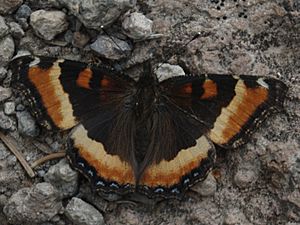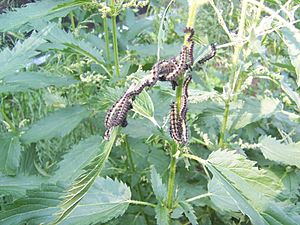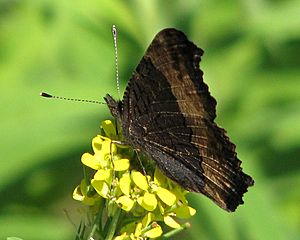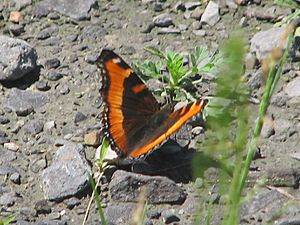Fire-rim tortoiseshell facts for kids
The Milbert's tortoiseshell, also known as the fire-rim tortoiseshell, is a beautiful butterfly found in North America. It's the only butterfly of its kind, the Aglais genus, that lives on this continent.
Quick facts for kids Milbert's tortoiseshell |
|
|---|---|
 |
|
| Scientific classification | |
| Subspecies | |
|
|
| Synonyms | |
|
Contents
What Does It Look Like?
The Milbert's tortoiseshell butterfly has a wingspan of about 4.2 to 6.3 centimeters (1.6 to 2.5 inches). The tips of its front wings are somewhat squared off.
The top side of its wings is mostly black. It has wide, bright orange bands near the edges. This orange color gently fades to yellow closer to the middle of the wing. Both the front and back wings have thin black borders. Sometimes, the back wings might also have small blue spots.
How Does It Behave?
This butterfly is very fast and flies quickly around paths in woodlands. When it decides to land, it often opens its wings. You might see it resting on trees or rocks.
Where Does It Live?
The Milbert's tortoiseshell butterfly lives across a large area. You can find it all over Canada and Alaska, but not in the very cold tundra regions. It also lives throughout the western United States and in most parts of the eastern United States.
These butterflies often prefer wet places. This includes damp fields, marshy areas, and along most trails and roadsides.
Its Amazing Life Cycle
Milbert's tortoiseshell butterflies usually have two generations, or "broods," each year. These broods appear from May to October. During this time, adult butterflies mate and lay their eggs.
A female butterfly will lay her eggs in large groups. She can lay up to 900 eggs at once! She places them on the underside of the leaves of certain plants. When the caterpillars first hatch, they are called early-instar caterpillars. They stay together and eat in a shared web. As they grow bigger, they start to feed alone.
When winter comes, the adult butterflies do not die. Instead, they hibernate, which means they go into a deep sleep. They often gather in small groups to do this. Sometimes, adults are seen mating near low-lying water areas in dry regions.
What Do Caterpillars Eat?

The young caterpillars of the Milbert's tortoiseshell butterfly love to eat certain plants. Their main foods are:
- Urtica dioica – This is also known as stinging nettle.
- Urtica procera – This plant is called tall nettle.
What Do Adult Butterflies Eat?
Adult Milbert's tortoiseshell butterflies enjoy a variety of foods. They often drink nectar from flowers like:
They also get nutrients from other sources, such as:
- Plant sap
- Rotting fruit
- Dung (animal waste)



